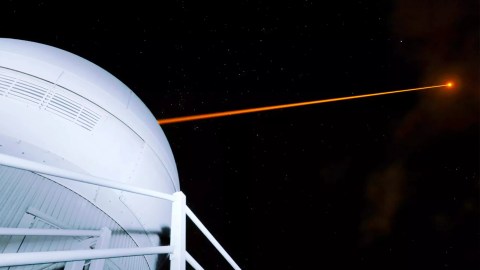Fusion startup plans to shoot space junk with lasers

- Millions of pieces of space junk are currently orbiting Earth.
- Japanese startup EX-Fusion is collaborating with EOS Space Systems to see if fusion-focused lasers can be used to remove space junk from orbit.
- The idea is to hit space junk with pulses from a ground-based laser, slowing it down it enough to fall and burn up in Earth's atmosphere.
A Japanese startup plans to point the lasers it is developing for nuclear fusion at the sky to see if they can knock space junk out of orbit.
Space debris 101: Millions of pieces of space junk — hardware humans sent into space and didn’t retrieve — are orbiting Earth, and because this space debris travels up to 18,000 miles per hour, a collision can seriously damage operational spacecraft.
NASA tracks debris larger than 10 centimeters and will take evasive maneuvers to prevent potential collisions, but something as small as a screw can be damaging, and as space gets more crowded, we’re going to need a way to track and, ideally, remove smaller space junk.
The power of a laser for destroying space junk is an order of magnitude lower than for nuclear fusion.
Kazuki Matsuo
Laser power: Japanese startup EX-Fusion is, as you might guess from the name, in the nuclear fusion business. Specifically, it’s developing a fusion reactor that will use lasers that apply force to objects (rather than just heating or cutting them) to compress hydrogen atoms until they merge.
The startup is now collaborating with EOS Space Systems, an Australian company that uses lasers to track space junk, to see if its fusion-focused lasers can be used to remove space trash from orbit.
“EX-Fusion’s work in laser-powered nuclear fusion complements our expertise in lasers and presents the potential for innovative solutions to the space debris problem,” said James Bennett, EOS Space Systems’ executive VP.
How it works: EX-Fusion plans to install one of its lasers at a ground-based space observatory operated by EOS Space Systems. The companies will then set up a system for tracking debris smaller than 10 cm.
After that’s established, they’ll try to remove pieces of space junk by hitting them with pulses from EX-Fusion’s laser, coming from the opposite direction that the debris is traveling. If this can slow the space debris down enough, it will fall and burn up in Earth’s atmosphere.
Looking ahead: There’s no word on when the two companies expect to test out the system, but EX-Fusion CEO Kazuki Matsuo is hopeful insights gleaned from the space junk project will leave his company better positioned to revolutionize the world of clean energy.
“The power of a laser for destroying space junk is an order of magnitude lower than for nuclear fusion, but they share technical challenges such as controlling them via special mirrors,” he told Nikkei Asia.
This article was originally published by our sister site, Freethink.





